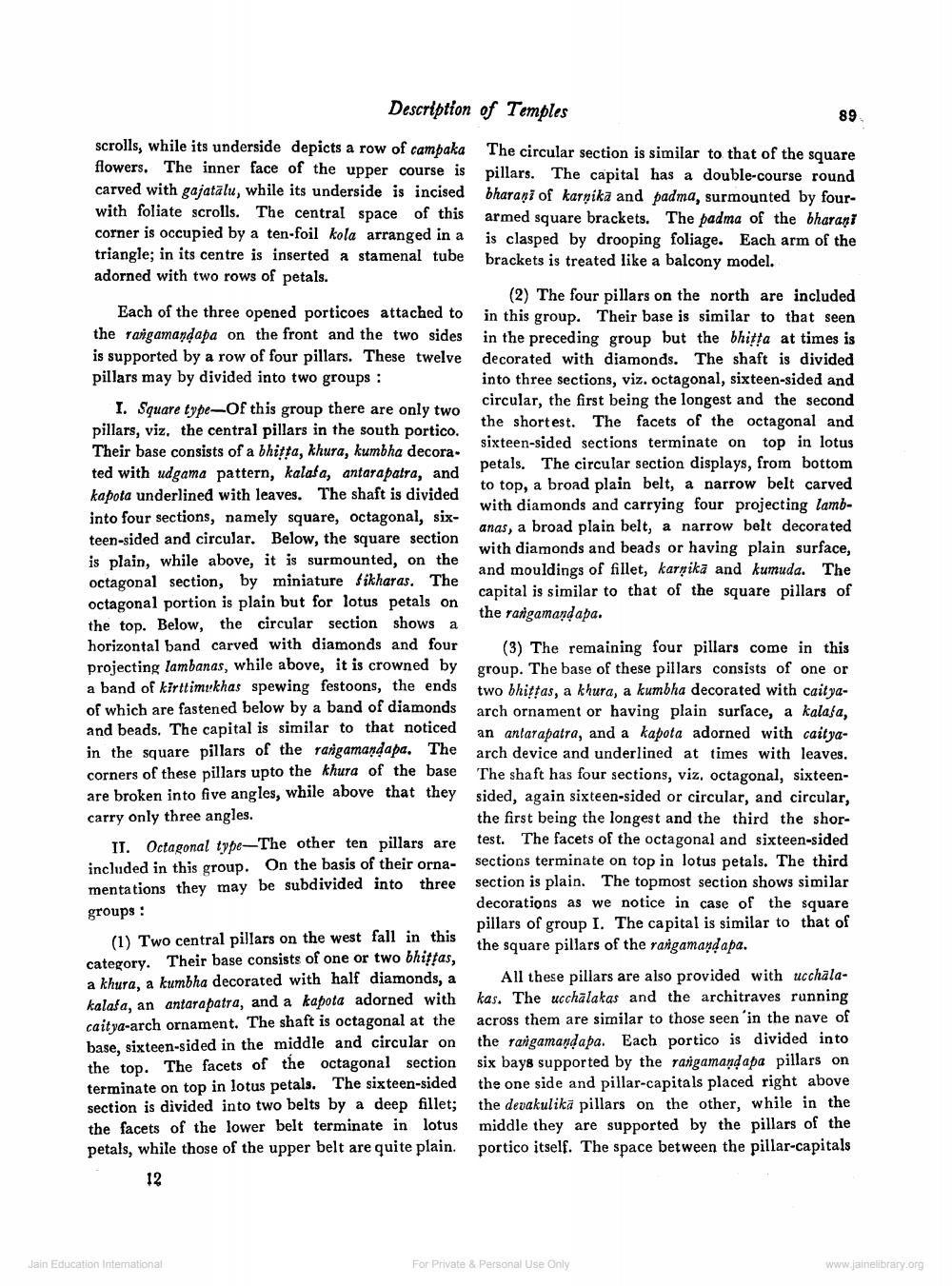________________
Description of Temples
89 scrolls, while its underside depicts a row of campaka The circular section is similar to that of the square flowers. The inner face of the upper course is pillars. The capital has a double-course round carved with gajatālu, while its underside is incised bharaṇi of karnika and padma, surmounted by fourwith foliate scrolls. The central space of this armed square brackets. The padma of the bharani corner is occupied by a ten-foil kola arranged in a is clasped by drooping foliage. Each arm of the triangle; in its centre is inserted a stamenal tube brackets is treated like a balcony model. adorned with two rows of petals.
(2) The four pillars on the north are included Each of the three opened porticoes attached to in this group. Their base is similar to that seen the rangamandapa on the front and the two sides in the preceding group but the bhitta at times is is supported by a row of four pillars. These twelve decorated with diamonds. The shaft is divided pillars may by divided into two groups :
into three sections, viz. octagonal, sixteen-sided and I. Square type-Of this group there are only two
circular, the first being the longest and the second pillars, viz. the central pillars in the south portico.
the shortest. The facets of the octagonal and Their base consists of a bhitta, khura, kumbha decora.
sixteen-sided sections terminate on top in lotus ted with udgama pattern, kalata, antarapatra, and
petals. The circular section displays, from bottom
to top, a broad plain belt, a narrow belt carved kapota underlined with leaves. The shaft is divided
with diamonds and carrying four projecting lambinto four sections, namely square, octagonal, six
anas, a broad plain belt, a narrow belt decorated teen-sided and circular. Below, the square section
with diamonds and beads or having plain surface, is plain, while above, it is surmounted, on the
and mouldings of fillet, karnika and kumuda. The octagonal section, by miniature Sikharas. The
capital is similar to that of the square pillars of octagonal portion is plain but for lotus petals on
the rangamandapa. the top. Below, the circular section shows a horizontal band carved with diamonds and four (3) The remaining four pillars come in this proiecting lambanas, while above, it is crowned by group. The base of these pillars consists of one or a band of kirttimukhas spewing festoons, the ends two bhittas, a khura, a kumbha decorated with caityaof which are fastened below by a band of diamonds arch ornament or having plain surface, a kalaša, and beads. The capital is similar to that noticed an antarabatra, and a kapota adorned with caityain the square pillars of the rarigamandapa. The arch device and underlined at times with leaves. corners of these pillars upto the khura of the base The shaft has four sections, viz, octagonal, sixteenare broken into five angles, while above that they sided, again sixteen-sided or circular, and circular, carry only three angles.
the first being the longest and the third the shorII. Octagonal type-The other ten pillars are test. The facets of the octagonal and sixteen-sided included in this group. On the basis of their orna- sections terminate on top in lotus petals. The third mentations they may be subdivided into three section is plain. The topmost section shows similar
decorations as we notice in case of the square groups :
pillars of group I. The capital is similar to that of (1) Two central pillars on the west fall in this
the square pillars of the rangamandapa. category. Their base consists of one or two bhittas, a khura, a kumbha decorated with half diamonds, a All these pillars are also provided with ucсhalakalata, an antarapatra, and a kapota adorned with kas. The ucchālakas and the architraves running caitya-arch ornament. The shaft is octagonal at the across them are similar to those seen in the nave of base, sixteen-sided in the middle and circular on the rangamandapa. Each portico is divided into the top. The facets of the octagonal section six bays supported by the rangamandapa pillars on terminate on top in lotus petals. The sixteen-sided the one side and pillar-capitals placed right above section is divided into two belts by a deep fillet; the devakulikā pillars on the other, while in the the facets of the lower belt terminate in lotus middle they are supported by the pillars of the petals, while those of the upper belt are quite plain. portico itself. The space between the pillar-capitals
12
Jain Education International
For Private & Personal use only
www.jainelibrary.org




